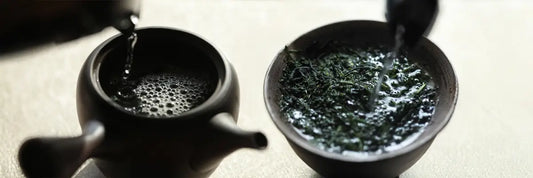Gyokuro brewing temperature is something that puzzles many people. Compared to other types of teas, the optimal temperature for gyokuro is much lower, almost lukewarm. In this article, we are going to discuss why the gyokuro tea brewing temperature is so low, and how you can prepare a great tasting cup of gyokuro tea.
Why gyokuro brewing temperature matters
What is Gyokuro?
A quick refresher of what gyokuro is might help you understand a little bit more about how to brew this tea. Gyokuro is considered to be the most sought after leaf tea in Japan and it was once the tea of choice for the emperor.
Based on the official gyokuro definition, the leaves need to be shaded for 3 weeks before the harvest. By cutting the gyokuro plants off from sunlight, they develop less bitterness, and maintain more of these sweet and savory flavors. To harvest gyokuro, the farmer takes the top 3 leaves as these are the highest in nutrients and richest in flavor. These leaves are then steamed, tightly rolled and dried to produce delicious gyokuro.
Why temperature matters when it comes to gyokuro
Before we talk about the best gyokuro tea temperature, we first have to talk about why temperature matters when it comes to gyokuro, and with tea in general.
First, with the exception of matcha, tea isn’t mixed directly into water, it is infused into water. That means that some compounds in the tea are going to stay inside the leaf, and some are going to make it into the cup. This is why the brewing parameters are so important. The temperature and time you brew the tea will determine what is extracted from the tea, and ultimately what ends up in the final cup.
So the next time someone tries to tell you that the gyokuro water temperature doesn’t matter, you can explain that it creates an entirely different tea. It would almost be like baking a cake using different ingredients. What is extracted from the leaf, determines what is in the tea.
Using the wrong gyokuro water temperature can make it bitter
Catechins are the bitter components within tea, and they tend to be extracted at a higher temperature. As a result, if the gyokuro tea temperature you use is too high, you will extract more catechins and more bitterness from the tea leaves. This is why it is incredibly important to use a lower gyokuro green tea temperature. You can even cold brew gyokuro, for a smooth, refreshing drink in the summertime.
How to brew gyokuro green tea step by step
Gyokuro brewing is a delicate process that can be easy to get wrong. We wrote a dedicated article about the topic called 👉 Gyokuro Brewing Guide by Tea Experts. In this gyokuro tea brewing guide, we are going to take you through the process of gyokuro brewing step by step. Bellow you can find a quick summary of the article 👇
- Measure out 5 grams of leaves and place them in the bottom of your teapot.
- Pour in 150ml of water at a temperature of 140 degrees fahrenheit.
- As you pour, makes sure not to pour directly on top of the leaves, as this will agitate them and release slightly more bitterness
- Put the lid of the teapot on to keep the tea warm, and let it sit undisturbed for 2 minutes
- Make sure to pour the gyokuro very gently so that you don’t agitate the leaves, but once the pouring stops, you can shake out the last few drops.
What is the best temperature for gyokuro
The best temperature for gyokuro is 140 degrees fahrenheit or 60 degrees celsius. This will make sure that you extract plenty of flavor from the leaves, without extracting much of the bitterness. You can use 5 grams of leaves, 150ml of water and a brewing time of 2 minutes to give the leaves enough time to open up and fully release their flavor into the water.
Gyokuro tea is meant to be a celebration of these sweet and savory flavors, which come from the theanine. Luckily for gyokuro drinkers, the theanine can be extracted at a lower temperature. When you use a lower gyokuro tea brewing temperature, you extract all of the sweetness with none of the bitterness. You also get a lower caffeine green tea, which can be helpful as Gyokuro caffeine level is very high.
Where can you find gyokuro?
Now that you know the best temperature for gyokuro, you are ready to prepare your own! Where to buy gyokuro green tea is a question we often get asked, and the answer is a bit complicated. We wrote an entire article in which we will teach you everything you need to know before you buy gyokuro, how to buy gyokuro green tea and where to buy gyokuro. If you want to read it, here is the link for the article 👉 Where to buy gyokuro green tea.
Nio Teas
After traveling around Japan for the past few years, we have met with dozens of farmers and sampled many different gyokuro teas. We have found that the best gyokuro produced by Mr. Sakamoto truly is in a league of its own. He has been producing gyokuro tea without the use of pesticides or chemicals since 1985 and during that time he has developed his own organic fertilizer. He says that this fertilizer not only makes the tea plants strong, but also makes the tea more flavorful. He is able to grow great tasting green tea on this field without harming the natural ecosystem.

Cha musume
The most popular gyokuro from Mr. Sakamoto is the cha musume. This tea is made using the Yabukita cultivar, which is the most common tea variety in Japan. This tea has a nice sweetness, a direct savory flavor and some pleasant floral notes. Try this tea and let us know what you think!





1 comment
Hi! I’ve been following your weblog for a long time now and finally got the bravery to go ahead and give you a shout out from Dallas Texas! Just wanted to mention keep up the fantastic job!